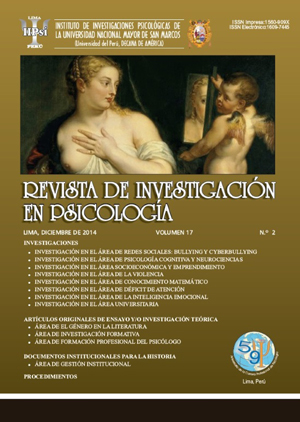Neuropsychological study of temperament and its relationship with associates attention disorders in children 7 to 8 years
DOI:
https://doi.org/10.15381/rinvp.v17i2.11263Keywords:
System, component affective-emotional, temperament, trastorn of attentionAbstract
The aim of the present investigation is to identify the mechanisms of deformation of the affective - emotive system and his relation with the disorders of attention in an intentional sample of 60 children between the ages from 6 to 7 years of age, who possess clinical history of evaluation of control of the healthy child from the first months of born up to the current control of the cohort in the period in December 2011 to November 2012.The instruments will be:The SNT designed by Sarria 2010 and Faces Test : Yale, 2006 in order to measure the disorders atentivos of the described sample, and the protocol of evaluation of control of the healthy child registered by the specialists pediatricians of HNERM at different stages of the children of these children ,in such a way that will be a design of cohort study (Hernandez, Fernandez & Baptista, 2010) with regard to the prospective follow-up of processes affective-emotional and attention deficits associated. For the analysis of the data will be used SPSS version 17, frequency distribution tables and percentages,Coefficient of Correlation Pearson and other parametric measures, showing the following conclusions:
1. The mother child interaction in the first stage of life has significant influence on the formation of emotional affective systm and this determined a posteriori indices of attention deficit.
2. There is a direct correlation between positive emotional development (load happy, mourn little in the presence of the mother and optimal orientation reflects voluntary attention (le optimal reception of stimuli).
3. There is a direct correlation between inadequate emotional development (they mourn frequently, even while in his mother arms) and poor reaction voluntary attention to changes in stimulation (le poor reception of stimuli).
Downloads
Published
Issue
Section
License
Copyright (c) 2014 César Sarria Joya, Victoria Llaja, Pedro García Pizarro

This work is licensed under a Creative Commons Attribution-NonCommercial-ShareAlike 4.0 International License.
THE AUTHORS RETAIN THEIR RIGHTS:
a. The authors retain their trademark and patent rights, and also on any process or procedure described in the article.
b. The authors retain the right to share, copy, distribute, execute and publicly communicate the article published in the Journal of Research in Psychology (for example, place it in an institutional repository or publish it in a book), with acknowledgment of its initial publication in the Journal of Research in Psychology.
c. Authors retain the right to make a subsequent publication of their work, to use the article or any part of it (for example: a compilation of their work, lecture notes, thesis, or for a book), provided that they indicate the source. of publication (authors of the work, magazine, volume, number and date).






